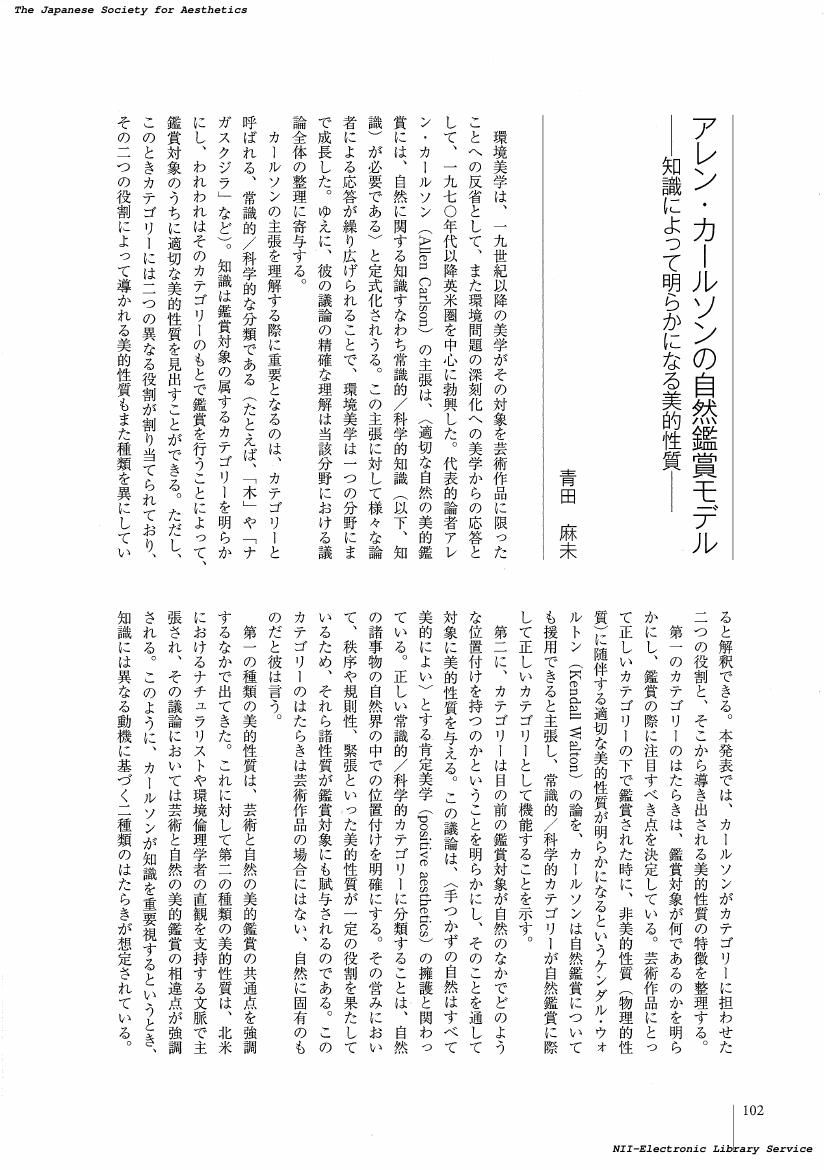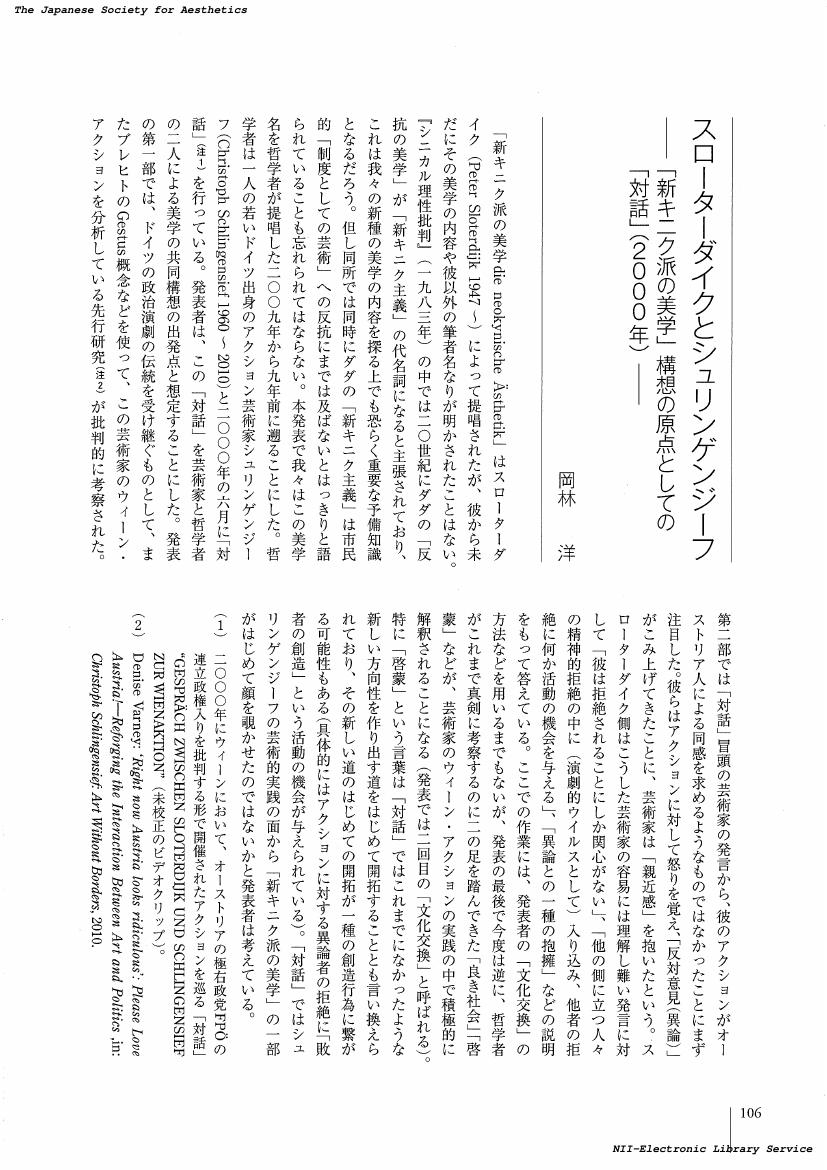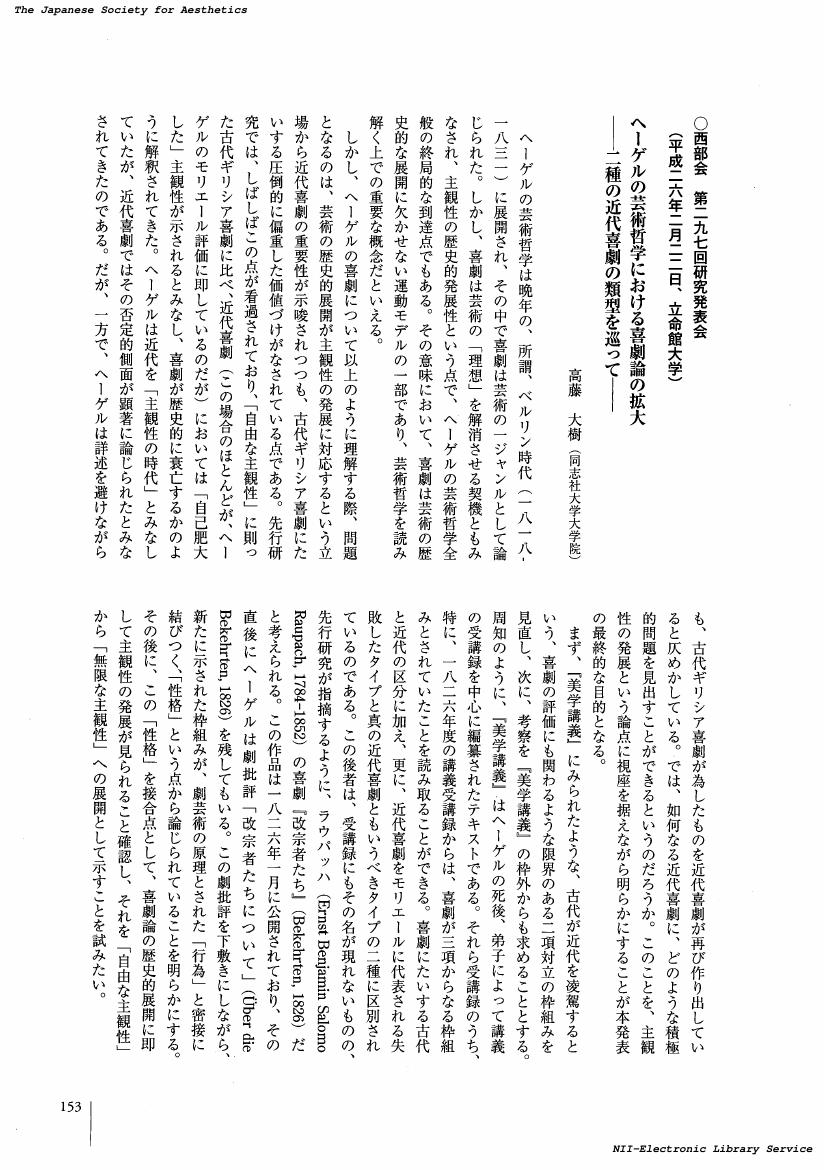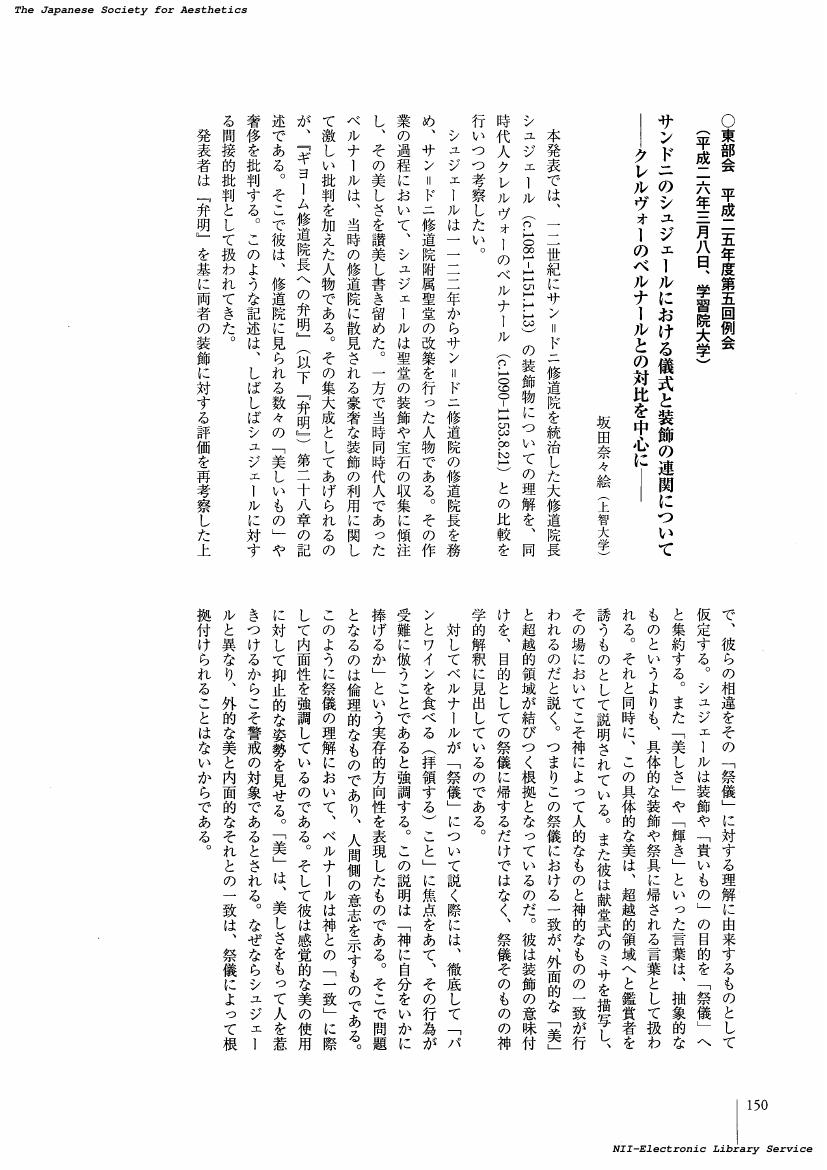1 0 0 0 OA 日本国際美術展(東京ビエンナーレ)再考 : 戦後日本における国際美術展の志向性
- 著者
- 山下 晃平
- 出版者
- 美学会
- 雑誌
- 美学 (ISSN:05200962)
- 巻号頁・発行日
- vol.65, no.2, pp.85-96, 2014-12-31 (Released:2017-05-22)
This paper takes up "The Japan International Art Exhibition (Tokyo Biennale)", the first international art exhibition in Japan after World War II. In 1952, the first exhibition was held under the auspices of the Mainichi Newspaper Company until 1990, the 18th and last one. During this time, the exhibition was unavoidably changed by the movements of the times, but we still haven't researched the exhibitions as a whole. In this paper, I have collected numerous articles about "The Japan International Art Exhibition" and have inspected the intentions. As a result, we can find that the intentions shifted from the "across-the-board" structure in the situation of "Japan against the World" to "avantgardism". In being avant-garde, on the other hand, the exhibition had the condition of a conservative bias against the West's sense of values or systematized "Art". With the end of the binomial opposition of "Japan and the World", "simultaneity" was then pursued, but the "Japanese originality" in the "simultaneity" wasn't pursued carefully enough. Japan has continually been involved with the problem of institutionalizing "Art" and the context peculiar to Japan since modern times. After WW II it was again expressed in this international exhibition. Thus, "The Japan International Art Exhibition" formed an important stage for criticism in Japan after WW II and has always relativized the position of "Japan".
- 著者
- 青田 麻未
- 出版者
- 美学会
- 雑誌
- 美学 (ISSN:05200962)
- 巻号頁・発行日
- vol.65, no.2, pp.102, 2014-12-31 (Released:2017-05-22)
- 著者
- 荒木 文果
- 出版者
- 美学会
- 雑誌
- 美学 (ISSN:05200962)
- 巻号頁・発行日
- vol.65, no.2, pp.103, 2014-12-31 (Released:2017-05-22)
- 著者
- 江本 紫織
- 出版者
- 美学会
- 雑誌
- 美学 (ISSN:05200962)
- 巻号頁・発行日
- vol.65, no.2, pp.104, 2014-12-31 (Released:2017-05-22)
1 0 0 0 OA 見立ての詩学 : 擬えと転用の弁証法(第六十五回美学会全国大会発表要旨)
- 著者
- 大石 昌史
- 出版者
- 美学会
- 雑誌
- 美学 (ISSN:05200962)
- 巻号頁・発行日
- vol.65, no.2, pp.105, 2014-12-31 (Released:2017-05-22)
- 著者
- 岡林 洋
- 出版者
- 美学会
- 雑誌
- 美学 (ISSN:05200962)
- 巻号頁・発行日
- vol.65, no.2, pp.106, 2014-12-31 (Released:2017-05-22)
- 著者
- 小田 藍生
- 出版者
- 美学会
- 雑誌
- 美学 (ISSN:05200962)
- 巻号頁・発行日
- vol.65, no.2, pp.107, 2014-12-31 (Released:2017-05-22)
- 著者
- 紙屋 牧子
- 出版者
- 美学会
- 雑誌
- 美学 (ISSN:05200962)
- 巻号頁・発行日
- vol.65, no.1, pp.152, 2014-06-30 (Released:2017-05-22)
- 著者
- 高藤 大樹
- 出版者
- 美学会
- 雑誌
- 美学 (ISSN:05200962)
- 巻号頁・発行日
- vol.65, no.1, pp.153, 2014-06-30 (Released:2017-05-22)
- 著者
- 吉田 寛
- 出版者
- 美学会
- 雑誌
- 美学 (ISSN:05200962)
- 巻号頁・発行日
- vol.65, no.1, pp.154, 2014-06-30 (Released:2017-05-22)
- 著者
- 小田部 胤久
- 出版者
- 美学会
- 雑誌
- 美学 (ISSN:05200962)
- 巻号頁・発行日
- vol.65, no.2, pp.1-12, 2014-12-31 (Released:2017-05-22)
In diesem Aufsatz gent es darum, welchen Beitrag Kants "Kritik der Urteilskraft" (im Folgenden KU) zum Konzept der Asthetik als Aisthetik, das uns zu einer neuen Interpretation der modernen Asthetik veranlasst, leisten kann. Dabei ist erstens der Begriff der Einbildimgskraft zu interpretieren, die in der KU als "Vermogen der Anschauung" bzw. "Vermogen der Sinnlichkeit" definiert ist. In der KU behandelt Kant, seiner Argumentation in der ,,Kritik der reinen Vernunft" (im Folgenden KrV) folgend, die Einbildungskraft zunachst in zweifacher Hinsicht: einmal als "Vermogen der Auffassung" des Mannigfaltigen der Anschauung und zum anderen als "Vermogen der Darstellung" der Begriffe. Doch uber die KrV hinausgehend, thematisiert Kant in der KU im Rahmen seiner Analyse der Vermogen, die das asthetische Urteil uber das Schone und das Erhabene ermoglichen und das Genie ausmachen, die selbstandige, ja sogar schopferische Tatigkeit einer Einbildungskraft, die dem Verstand nicht untergeordnet ist. Zweitens ist Kants Behauptung zu erortern, dass wir uns des Spiels der Erkenntniskrafte "asthetisch durch den blossen inneren Sinn" "bewusst werden" (KU § 9). Das bedeutet m. E., dass der innere Sinn, der in der Formel "Ich fuhle mich" zu fassen ist, der Apperzeption, also dem Selbstbewusstsein des "Ich denke", zugrunde liegt und uns unsere Existenz bzw. unser Leben asthetisch bewusst macht.
- 著者
- 宇多 瞳
- 出版者
- 美学会
- 雑誌
- 美学 (ISSN:05200962)
- 巻号頁・発行日
- vol.65, no.2, pp.13-24, 2014-12-31 (Released:2017-05-22)
La notion de lyrisme est apparue au XIX^e siecle, et elle est generalement l'expression de sentiments personnels du poete sur les themes de l'amour, de la nature, de la religion, de la mort, etc. Cette notion etait reliee a l'elevation spirituelle de l'artiste et etait souvent jugee negativement a cause de son exces de sentiments. Mais Jean-Michel Maulpoix fait remarquer le caractere moderne du lyrisme romantique et revoie la signification de la notion de lyrisme en reconsiderant la transformation des figures du sujet lyrique chez Baudelaire. En se basant sur les recherches de Maulpoix, cette etude aborde la maniere dont la notion de lyrisme est consideree par Reverdy, Breton, Dermee et Le Corbusier. Reverdy refuse d'admettre l'elevation et l'expression sentimentale du lyrisme et Breton insiste sur l'inactivite du sujet lyrique. Dermee considere quant a lui le lyrisme comme un mecanisme de la sensation du subconscient. Par ailleurs, Le Corbusier base le lyrisme sur le fondement de techniques et fait l'eloge de la creativite et de la noblesse de l'artiste. Par le biais des artistes du debut du XX^e siecle, le lyrisme est redefini comme la recherche de nouvelles expressions du sujet lyrique.
1 0 0 0 OA 喜多院本「職人尽絵屏風」の制作意図について : 近世初期風俗画との比較からの考察
- 著者
- 奈良 葉子
- 出版者
- 美学会
- 雑誌
- 美学 (ISSN:05200962)
- 巻号頁・発行日
- vol.65, no.2, pp.25-36, 2014-12-31 (Released:2017-05-22)
Paintings of craftsmen, Shokunin-e, portray people of various occupations. While early Shokunin-e paintings in the medieval period illustrate craftsmen without any background, Shokunin-e paintings in the early modern period depict people working at their workshops, and the Kitain-version is the most notable example of the latter. The previous studies argue that the Kitain-version's depictions are taken out from those of paintings of the scenes in and around the capital (Rakuchu-Rakugau-zu). This paper, however, argues that, while the Kitain-version is obviously under some influence of Rakuchu Rakugai-zu and other genre paintings, important features of the Kitain-version, which are different from depictions in other genre paintings, should be examined. Based on discussions on these features with comparisons to other early modern genre paintings, this paper concludes as follows. First, paintings with focus on the life of ordinary people gained popularity in the early 17th century, and its root lied in the Oda-Toyotomi era. Second, the Kitain-version, however, is more than just depicting citizen's life. By incorporating traditional Shokunin-e style, it illustrates craftsmen as people with distinguished skill and social status. The purpose of the Kitain-version was not just to illustrate ordinary people but also to honor them, which was innovative compared to its contemporary genre paintings.
- 著者
- 大久保 尚子
- 出版者
- 美学会
- 雑誌
- 美学 (ISSN:05200962)
- 巻号頁・発行日
- vol.65, no.2, pp.37-48, 2014-12-31 (Released:2017-05-22)
In this paper, I examined the position of ehon with kachoga like eiri-haisho (collection of haiku with picture) as resource for textile design. In the early mid-18^<th> century, some kosode-hinagatabon artists started to depict the designs of various plants in picture-like style with reality. Though designs based on kachoga became one of the typical textile designs in late Edo, such attempts did not become widespread in kosode-hinagatabon. Meanwhile, in the first part of the 18th century, Ehon with kachoga by professional artists began to be published. Some of them were art manuals, while others were books mainly for visual entertainment, such as eiri-haisho. Although both could be applied to kachoga-like design, the former was used mainly by craftsmen or merchants, while the latter fascinated the readers with their kachoga illustrations and inspired new design devices. We verified, by investigating the reprint editions, that Ehon Fukujuso and Haikainanosiori, which are eiri-haisyo with picture of various plants, have been recognized also as reference material for creating new designs. Borderless connection between aesthetic appreciation and practical use is one of the characteristics of the relation between publications and textile designs in the late Edo period.
- 著者
- 関野 さとみ
- 出版者
- 美学会
- 雑誌
- 美学 (ISSN:05200962)
- 巻号頁・発行日
- vol.65, no.1, pp.147, 2014-06-30 (Released:2017-05-22)
- 著者
- 太田 純貴
- 出版者
- 美学会
- 雑誌
- 美学 (ISSN:05200962)
- 巻号頁・発行日
- vol.65, no.1, pp.148, 2014-06-30 (Released:2017-05-22)
- 著者
- 奈良 葉子
- 出版者
- 美学会
- 雑誌
- 美学 (ISSN:05200962)
- 巻号頁・発行日
- vol.65, no.1, pp.149, 2014-06-30 (Released:2017-05-22)
- 著者
- 坂田 奈々絵
- 出版者
- 美学会
- 雑誌
- 美学 (ISSN:05200962)
- 巻号頁・発行日
- vol.65, no.1, pp.150, 2014-06-30 (Released:2017-05-22)
- 著者
- 谷嶋 美和乃
- 出版者
- 美学会
- 雑誌
- 美学 (ISSN:05200962)
- 巻号頁・発行日
- vol.65, no.1, pp.151, 2014-06-30 (Released:2017-05-22)
1 0 0 0 OA ヘンリー・フュースリのキアロスクーロに見られる超自然現象の視覚的文脈
- 著者
- 松下 哲也
- 出版者
- 美学会
- 雑誌
- 美学 (ISSN:05200962)
- 巻号頁・発行日
- vol.65, no.1, pp.61-72, 2014-06-30 (Released:2017-05-22)
Henry Fuseli(1741-1825)'s works that have supernatural subjects such as ghosts, demons, or fairies, are often painted with very strong contrast of light and shade. But in his Lectures on Painting, he claimed that such are not legitimate chiaroscuro, and too strong beam or ray must be a "terror on the eye", because chiaroscuro is a method to compose art in literary unity, and the unity is "inseparable from legitimate chiaroscuro" for his "poetic imitation" theory. Some latter studies show us that Fuseli's paintings have visual elements of theatres and shows like magic lantern or phantasmagoria. But, these observations are not enough to illustrate his method and context of phenomenon, because his art historical discipline that affected to his composition has not been well mentioned yet. Supernatural beings are often painted as forms in nearly "illegitimate chiaroscuro", which means, he painted them as superpictorial beings that alien to whole composition. His style of gothic horror was based on his meta-painting strategy and it was established by applying visual context of modern entertainment to his art historical discipline.













